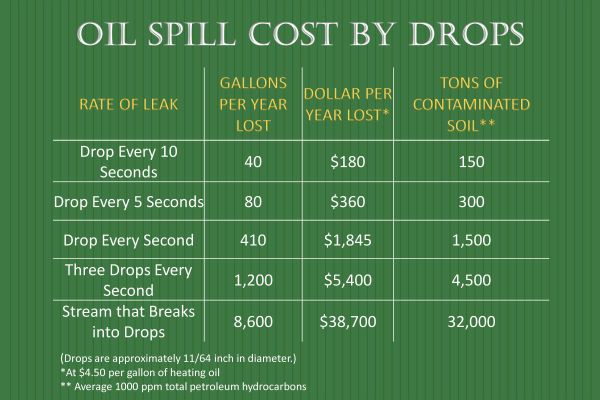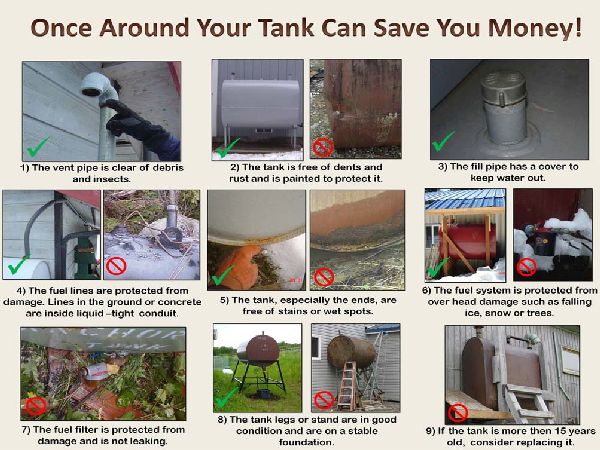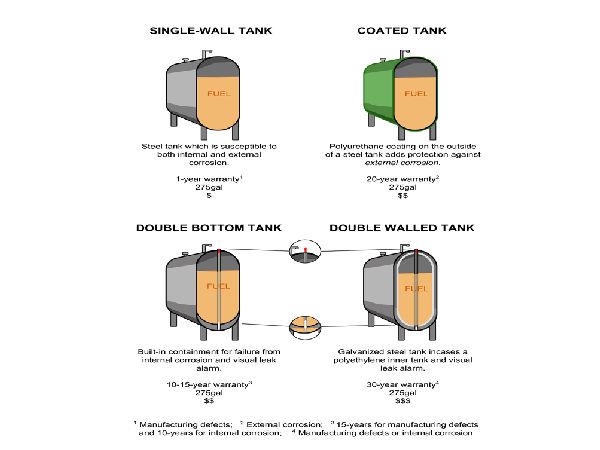Home Heating Oil Tank Guidance
Spills from residential heating oil tank systems and the resulting contamination are ongoing and widespread problems across Alaska.
The Prevention Preparedness and Response Program works with numerous property owners every year to cleanup spills caused by leaking or failed home heating oil tank systems. In addition to the negative impact to the environment, residential heating oil spills can be expensive for the property owner, both in terms of cleaning up the environment and also the value of the lost fuel. Property values may also be diminished in association with contamination that has not been addressed. By taking the preventative measures outlined on this page, property owners with residential fuel oil tank systems can greatly reduce the chances of having a heating oil spill.
Aside from possible state and local fire codes, Alaska does not have regulations that govern the installation or maintenance of heating oil tank systems. Homeowners are entirely responsible for the installation, maintenance and integrity of heating oil tanks, lines and fittings. Alaska does have statutes and regulations that govern releases from home heating oil tank systems.
Facts and Figures
Guidance Documents
- Above Ground Heating Oil Tank Inspection Guide
- Underground Heating Oil Tank Inspection Guide
- Home Heating Oil Tank Installation Guidelines
- Buying a Home
- Inspection Checklist
- Underground Heating Oil Tank Closure Guide
HHOT Response Funding *NEW*
HHOT Emergency Preparedness
- Preventing Spills During Flooding Events
- Earthquakes, Floods, and Home Heating Oil Tanks
- Protecting Building Utility Systems from Flood Damage: Section 4.4.2 Mitigation for Fuel Systems and Tanks (FEMA Mitigation Measures for Residential Buildings)
- Pages 4-45 thru 4-50
- CDC Guidelines for Protecting Yourself From Chemicals After a Disaster
- CS Flood Guidance Forms
Public Service Announcements
Flooding Protection (updated February 2019)
- Transcript
-
Flooding and ice jams are a fact of life in many parts of Alaska.
Are you ready?
Help avoid costly cleanup and damage to the environment by protecting your home heating oil system.
During a flood warning close all fuel tank connections, make sure piping is properly elevated, and anchor tanks to prevent them from being swept away.
Technical resources are available at dec.alaska.gov. Click on spill prevention and response for the home heating oil tanks link or to report a spill.
This message is sponsored by the Alaska Department of Environmental Conservation.
Winterization (updated February 2019)
- Transcript
-
Prepare your home heating oil system now for snow and ice to help avoid costly cleanup and damage.
Keep tanks and piping away from areas with high traffic.
Ensure connections are flexible to give them space to move with the freeze/thaw cycle.
Tanks should not be placed directly under the eaves of houses in case of falling snow.
Technical resources are available at dec.alaska.gov. Click on spill prevention and response for the home heating oil tanks link or to report a spill.
This message is sponsored by the Alaska Department of Environmental Conservation.
General Inspection/Maintenance (updated February 2019)
- Transcript
-
Protect your property from costly spills and leaks by inspecting your home heating oil system.
Track your fuel consumption because dramatic increases in fuel use may indicate your tank or fuel line is leaking.
Check your tank vent for any obstructions such as snow, ice, and insects.
Replace your tank if it is rusting or if it appears damp.
Create a regular maintenance plan.
Technical resources are available at dec.alaska.gov. Click on spill prevention and response for the home heating oil tanks link or to report a spill.
This message is sponsored by the Alaska Department of Environmental Conservation.






 Indicates an external site.
Indicates an external site.